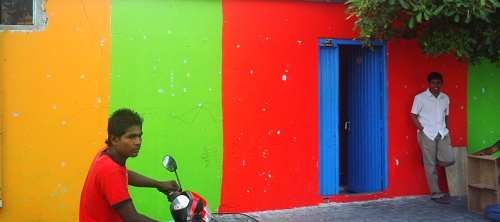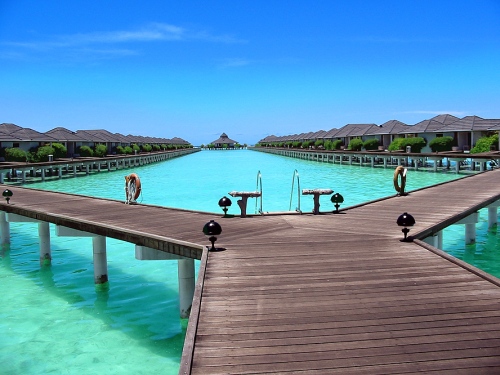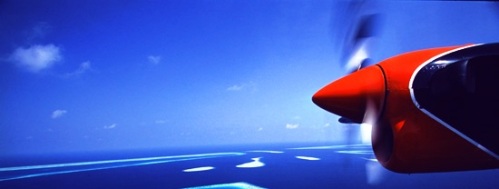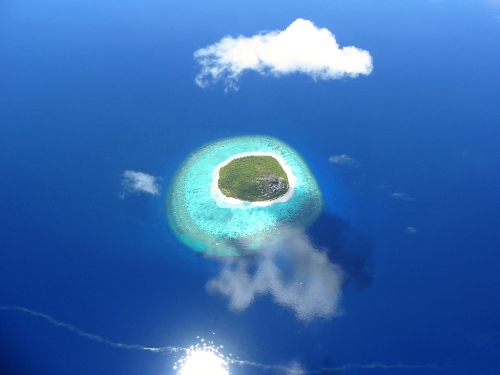
Out of all the countries in this world, The Maldives is the only one whose capital is an island. There are several others whose capital is on an island, but no other capital fills out the island edge to edge, shore to shore, like Male’. There are 1190 islands as a whole, but still 1 in 4 Maldivians live on Male’. There are almost 80k people concentrated within the island’s 1,7 sq km(slightly bigger than Monaco). Though bursting, it still maintains an air of quiet living and unhurried activity, as if it were some market town of Mediteranean South Europe.
Walking along the harbour’s front, the place where the boats moor, or just looking at the people pass by, one would notice a variety of facial features in the faces of the people. The long line of island strung across the trade routes of the Indian Ocean is bound to receive visitors, voluntary or otherwise, welcome or not. As a result, each of this voyagers left some mark in the faces of the present day Maldivians.
The first were the merchants from the seafaring nation of Gujarat. This would have been from around 500 BC. Then the Tamils came from Sri Lanka.Then Tamils from the deep south of India.The Persians dominated the Indian Ocean centuries later dealing regularly with the Maldivians. Then the Arabs took over for good. In this pot-pourry of genetic influences must be added also the Africans, first of whom came as trade slaves. There is 2 parts in the history of Maldivians. Before and after the conversion to Islam. This was made in 1153. Ibn Battuta, was the first to write it down during his staying in Male, serving as a judge.To this day, in the country there are 100% Muslim peole, being also the smallest state with a Muslim majority.

The most important political, cultural and economic centre of the country is based here. It’s the place where you really see the lifestyle of the Maldivians and get the feel and feel the pulse of this small nation.
The water front is very busy: Slick new designed buildings, lot of people bustling around, talking on mobiles, riding scooters. The residential areas in the interior of the island, during the mid-day when the sun is severe, are relaxed, with few people looking for the shady part of the road, others sitting and chating in their door steps. You can easily mingle with them by just going to have your tea and tiffin at a local tea shop. Or if you want to see the youngsters, you can have a pricey swanky cocktail by the cafes with a terrific view of an endless azure Ocean. The city has also a strong community of expats, some 20k, with around 10% Europeans. The others are honest hard working people from Sri Lanka, India and Bangladesh.
Land reclamation and the break waters now extend to the outer edge of the surrounding reef, and there is no possibility of enlarging the island. So, the further growth can only be accommodated by more high-rise buildings or on neighboring islands. I personally dislike that charming old buildings are demolished to make way for bigger modern structures. In the 80’s they were aloud to build up to 5 storeys. Present days, the number is 12.
A funky feature is the rounded corners of walls and buildings at the junctions, to make it easier for vehicles to negociate tight corners. New buildings, they have the look of undistinguished boxes. Somehow they are reminiscents of the Bauhaus style, but something you might spot in Germany.

The Grand Friday Mosque with an attached Islamic center was build with help from the Gulf states, Brunei, Malaysia and Pakistan. At the time of construction in ’84 it used to dominate the skyline of Male’. But still approaching with a boat, you can still seethe golden dome, glinting in the sun (actually the gold isanodised aluminium, but it’s still golden shinny). Inside there can be around 5 thousand whorshipers, and of course on Friday for the Jumma prayer it’s a fine set to see.There are beautiful wooden panels, an especially woven carpet ( looks Azeri to me) and grand chandeliers. The near old mosque is interesting but the corrugated iron roof it’s putting the place in a modern artificial look. Opposite the road I spotted a park, with the National Museum inside the courtyard. It’s a small building now, the only remaining part of the sultan’s palace(the rest was demolished in 1968 at the beginning of the 2nd republic).
Among the things in the small collection I did like some fabrics (with rich brocades), some laquer work( awesome!) displayed on large bowls, and a Silvan Banthi(used by husbands to punish an unfaithful wife). Some interesting pre-Islamic stone carvings collected by Thor Heyerdahl, are there also: a fine Budha head and various phallic images. But no one seems to know about the significance or the historical context of this finds.
If you have the energy, and like to walk, like myself, you can easily circumnavigate Male’.You can walk around the whole island, or even run around it. It’s commonly used by football clubs (or club?) military squads or joggers.











